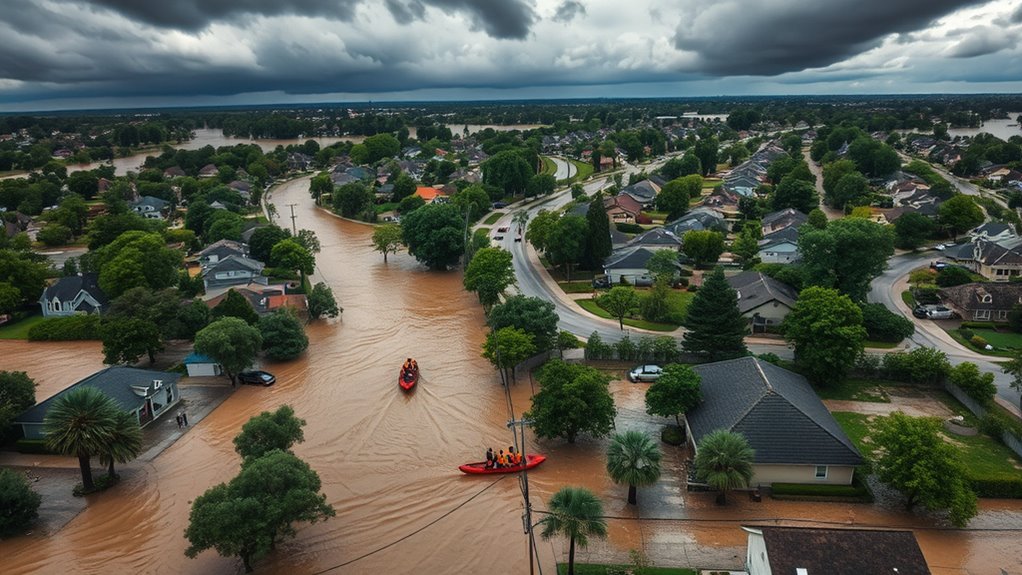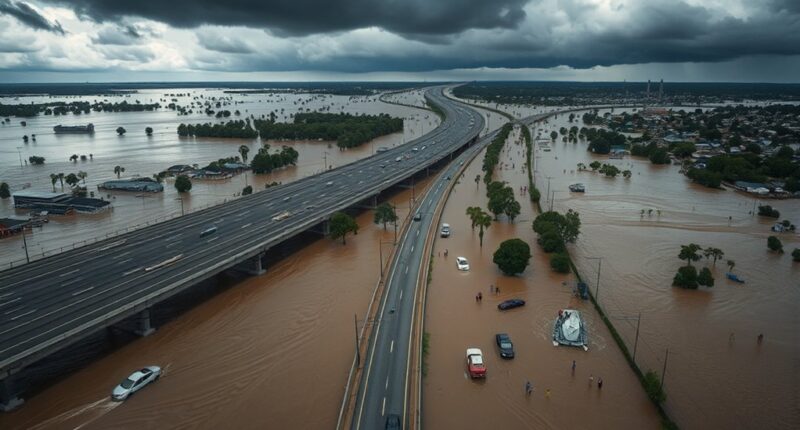Heavy rains in Texas have forced over 100,000 people to evacuate as record flooding overwhelms communities. Roads are submerged, homes are inundated, and emergency services are stretched thin. To stay safe, follow local alerts and evacuation orders immediately, and prepare an emergency kit with essentials. Recognizing infrastructure weaknesses and planning ahead can help protect you now and in future storms. Continue with this information to understand how you can better prepare for such extreme weather events.
Key Takeaways
- Over 100,000 residents in Texas have been ordered to evacuate due to ongoing record rainfall and severe flooding.
- Authorities are issuing urgent evacuation notices as floodwaters threaten homes and infrastructure.
- Emergency services are overwhelmed, emphasizing the importance of timely evacuation and preparedness.
- Flooding has submerged roads and bridges, complicating rescue efforts and requiring alternative routes.
- Community and individual preparedness, including emergency kits and safe locations, are vital during such extreme weather events.

As relentless rains continue to pour across Texas, authorities have ordered evacuations in several affected areas. The unprecedented flooding has overwhelmed local communities, exposing vulnerabilities in urban infrastructure that weren’t designed to handle such extreme weather events. Roads are submerged, homes are inundated, and emergency services are stretched thin, forcing residents like you to act quickly to ensure safety. These conditions highlight the critical importance of emergency preparedness, which can mean the difference between life and death in a disaster.
Your first priority should be to stay informed. Listen to local alerts and weather updates through your phone or battery-powered radio. Knowing where the floodwaters are rising and which areas are most affected allows you to make timely decisions about evacuating or seeking shelter. If authorities issue evacuation orders, follow them promptly and don’t wait until it’s too late. The chaos caused by flooding often leaves little time to gather belongings, so prepare an emergency kit in advance that includes essentials like water, non-perishable food, medications, important documents, and clothing. Keep this kit accessible so you’re ready to leave at a moment’s notice.
Stay informed with alerts and prepare an emergency kit for quick evacuation.
Understanding the vulnerabilities of urban infrastructure helps you grasp why flooding occurs so rapidly and severely. Many city drainage systems are outdated or overwhelmed by the volume of rain, leading to streets turning into rivers. Bridges and roads may be compromised or inaccessible, complicating evacuation efforts. Being aware of these limitations encourages you to plan alternative routes and safe locations beforehand. It’s also wise to identify higher ground or designated emergency shelters in your area so you can move quickly if your neighborhood becomes unsafe. Additionally, incorporating sustainable urban planning principles can help mitigate future flood risks and improve resilience.
Emergency preparedness isn’t just about having supplies; it’s about knowing what to do before, during, and after a flood. Develop a family emergency plan that includes communication strategies, a meeting point, and responsibilities for each member. Practice this plan regularly so everyone knows their role when disaster strikes. Keep important contact information, including local emergency services and loved ones, handy. Meanwhile, stay vigilant about weather forecasts, especially if you live in a flood-prone zone, to avoid being caught off guard. Recognizing the urban infrastructure vulnerabilities helps you understand why floods happen so quickly and emphasizes the importance of community-wide resilience efforts. Being aware of emergency response procedures in your area can further enhance your safety during such crises. Preparing for such events also involves understanding how climate change impacts extreme weather patterns, which can help you anticipate future risks. Engaging in community disaster preparedness initiatives can strengthen collective resilience and response capabilities. In these challenging times, your proactive measures can drastically reduce risks and help protect you and your loved ones. Recognizing the weaknesses in urban infrastructure and prioritizing emergency preparedness ensures you’re better equipped to face the floodwaters and emerge safely on the other side.
Frequently Asked Questions
How Are Rescue Operations Being Coordinated Across Affected Areas?
You’re wondering how rescue operations are coordinated across affected areas. Community volunteers play a crucial role, providing immediate assistance and relaying information. Drone surveillance helps identify stranded individuals and assess flood extent quickly. Emergency teams communicate closely, utilizing these tools to prioritize evacuations and resource deployment. This coordinated effort ensures efficient rescues, minimizes risks, and helps communities recover more swiftly amid challenging conditions.
What Long-Term Recovery Plans Are in Place for Displaced Residents?
You should focus on community rebuilding efforts and policy reforms that support displaced residents. Long-term plans include providing affordable housing, mental health services, and job assistance, ensuring residents regain stability. Local governments are collaborating with NGOs to develop sustainable solutions, prioritize infrastructure improvements, and implement policies that prevent future disasters. Your involvement and feedback can help shape effective recovery strategies, fostering resilience and community strength in the aftermath of the floods.
How Are Local Businesses Coping With Evacuation and Flooding Impacts?
You see local businesses facing tough times with floods and evacuations, but many are boosting their resilience by securing flood insurance and implementing emergency plans. Some adapt quickly by shifting operations or offering online services to stay afloat. Community support and government aid also play crucial roles, helping businesses recover faster. Staying proactive and prepared can make a significant difference in minimizing long-term impacts from such natural disasters.
What Mental Health Resources Are Available for Flood Victims?
Did you know that nearly 60% of flood victims seek mental health support after disasters? You can access community counseling and crisis helplines designed to help you cope with stress, anxiety, and grief. Local organizations often provide free mental health resources, so don’t hesitate to reach out. Taking care of your mental health is vital, and support is available to guide you through recovery and help rebuild your resilience.
How Will Future Flood Risks Be Mitigated in Vulnerable Communities?
You can help mitigate future flood risks by supporting floodplain zoning initiatives that limit development in high-risk areas. Improving urban drainage systems also plays a critical role, ensuring water flows efficiently and reduces flooding. By advocating for these measures, you contribute to protecting vulnerable communities, minimizing damages, and creating safer environments. Combining zoning policies with enhanced drainage infrastructure offers a proactive approach to managing flood risks effectively.
Conclusion
As you witness the ongoing Texas floods, remember that over 100,000 people have already evacuated, highlighting the severity of the situation. With record rainfall exceeding 15 inches in some areas, the scale of this disaster is unprecedented. Staying informed and prepared is vital, as these extraordinary weather events remind us of climate change’s growing impact. Together, community resilience and proactive measures can help navigate these challenging times more effectively.








